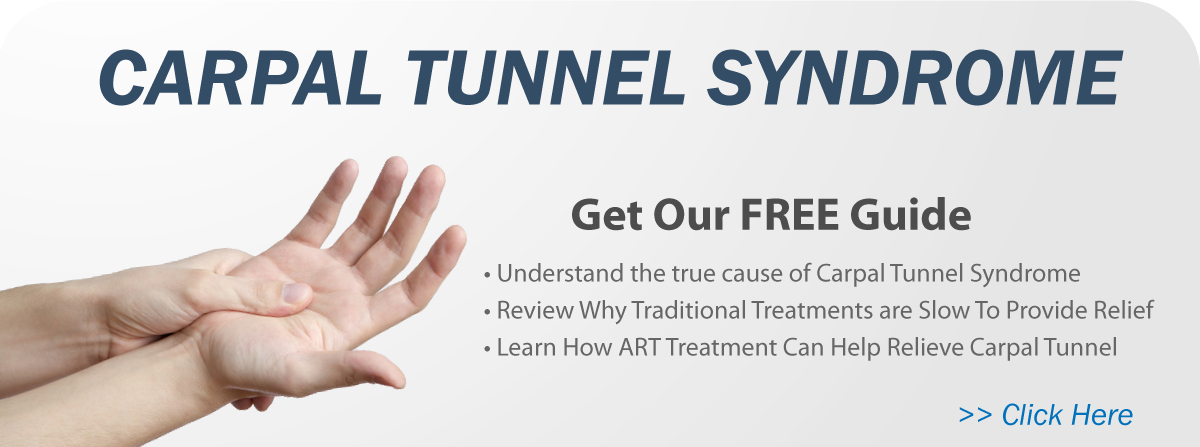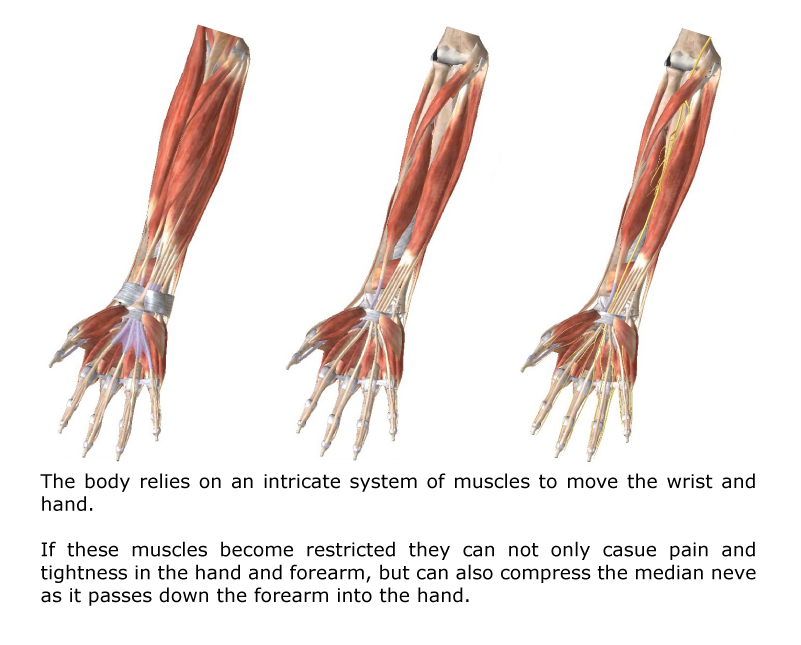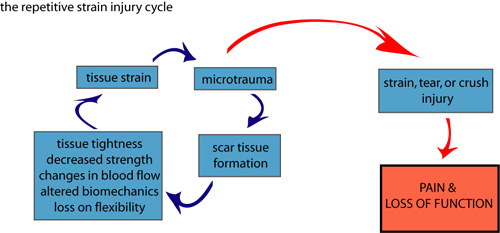[responsive] [/responsive][gap height=”30″]
[/responsive][gap height=”30″]
Improved Treatment For Carpal Tunnel Syndrome
Carpal Tunnel Syndrome and other hand and wrist conditions are becoming much more frequent in our world today. What makes matters worse is that these conditions are often slow to respond to traditional treatment methods.
In many cases surgery is recommended, although this is far from a perfect solution. All of this leads to frustration and uncertainty for those suffering with Carpal Tunnel Syndrome.
But fortunately there is some good news……
A new treatment technique known as Active Release Techniques (ART) is proving to be a very effective method for many Carpal Tunnel Syndrome cases.
If you are not familiar with ART treatment you’re not alone. This is a relatively new treatment method. So in this article we will discuss the basics of what you need to know about Carpal Tunnel Syndrome, including a review of ART treatment.
Here are the key things we will cover….
1 – The underlying cause of virtually every case of Carpal Tunnel Syndrome
2 – Why traditional treatments are often ineffective or slow to provide relief
3 – What ART Treatment is… and how is is so effective in treating Carpal Tunnel Syndrome
How Does Carpal Tunnel Syndrome Occur?
Whenever patients come into our office we like to make sure they have a basic understanding of their problem….. not just their diagnosis but also what has happened that has caused their problem in the first place.
When patients grasp this it is much easier for them to understand what needs to be done to fix the problem.
So lets take a look at how Carpal Tunnel Syndrome develops in the first place…..
The body relies on a complex system of muscles to protect and control the wrist and hand. In fact there are more than 30 different muscles that attach to the many bones of the wrist, hand, and fingers.
While some of these muscles are located in the hand itself, others are actually located up in the forearm. These muscles have long tendons that cross the wrist and attach to the bones of the hand and fingers.
In addition to the muscles the median nerve also travels along the front of the forearm and into the hand. This nerve supplies the skin, muscles, and joints of the hand, and is an important player in Carpal Tunnel Syndrome – as will be discussed below.
[responsive] [/responsive]
[/responsive]
Muscle Strain, Muscle Scarring, and Carpal Tunnel Syndrome
Any use of our hands will place some load and stress on the muscles of the forearm and hand. And it is not uncommon for these muscles to become strained or damaged from overuse.
While this is easily understood with physically demanding activities such as lifting, carrying, or pushing, other activities such typing can also be damaging as the muscles must be on for long periods time. This can restrict blood flow and cause muscle fatigue and overload.
Over time this strain and overload to the muscles can develop into small scale tissue damage known as micro-trauma.
Initially this micro-trauma is very small and the amount of damage is not enough to be painful. However this damage still needs to be repaired which the body does by forming new connective tissue known as scar tissue or soft tissue adhesions.
This scar tissue itself is not necessarily a problem. In fact, it is a normal and necessary part of healing. But a big problem does occur when the muscles of the wrist are repeatedly stressed over the course of weeks and months.
When this happens the muscles of the hand and forearm become caught in a repetitive strain cycle in which the same muscles are damaged and subsequently repaired over and over again. This process is associated with more and more scar tissue adhesion formation.
[responsive] [/responsive]
[/responsive]
Think of these adhesions like rust and grime that can build-up in an automobile. Normally the parts of the car should be well oiled and move smoothly but when rust and grime are allowed to build-up the car begins to break down until eventually it does not work properly and repairs are needed.
Just like rust, as these soft tissue adhesions begin to build up in and around the hand and forearm it leads to problems such as tightness, weakness, reduced muscle endurance, restricted joint motion, and diminished blood flow.
And while these adhesions themselves can cause pain and tightness into the hand or forearm the bigger problem with Carpal Tunnel Syndrome is that the tight and restricted muscles will begin to compress the median nerve as is passes through the forearm and into the hand.
In many cases adhesions can actually form between the median nerve and the surrounding muscles, essentially ‘gluing’ the nerve to the muscles and preventing it from moving and sliding during arm movements.
This results in the classic symptoms of Carpal Tunnel Syndrome, including pain, burning,n umbness. and weakness into the hand.
The Problem with Traditional Treatments for Carpal Tunnel Syndrome
Some of the traditional treatment methods used for Carpal Tunnel Syndrome include anti-inflammatory medications, ice or heat, ultrasound (US), acupuncture, wrist splints, stretching and strengthening exercises, and when all else fails, surgery.
Unfortunately, most of these traditional treatments generally require a long period of time before they provide any significant relief, or provide only temporary relief from symptoms instead of fixing the underlying cause of the problem.
The main reason these approaches are often ineffective is that they fail to address the underlying scar tissue adhesions that develop within the muscles and surrounding soft tissues.
Remember it is these adhesions which are binding the tissues together and compressing the median nerve.
Passive approaches such as medications, ice, acupuncture, ultrasound, and night spints all focus on symptomatic relief and do nothing to address muscle restrictions and dysfunction.
More active approaches, such as stretching and exercise are often needed to restore full strength and mobility but they do not treat the underlying adhesions. In fact, without first addressing the scar tissue adhesions, stretches and exercises are often less effective and much slower to produce relief or recovery.
Improved Treatment for Carpal Tunnel Syndrome with Active Release Techniques
So if all of these traditional treatments are not very successful for Carpal Tunnel Syndrome what is the solution?
We have found that Active Release Techniques (ART) treatment is the most effective, quickest, and most lasting treatment solution for Carpal Tunnel Syndrome.
Active Release Treatment (ART) was developed about 20 years ago by a doctor in the United States. This may seem like a long time ago but as far as treatment techniques go it is actually quite new – but it is making an big impact in healthcare and is becoming the treatment of choice for many musculoskeletal problems.
So let’s take a look at exactly what ART treatment is and why it is so effective in treating Carpal Tunnel Syndrome.

What is ART
Active Release is a hands-on treatment method to address problems in the soft tissues of the body, including the muscles, ligaments, and nerves. What makes ART different from other treatments is that it is specifically designed to identify and treat scar tissue adhesions that build up and compromise tissue health.
By locating and treating the soft-tissue adhesions with ART it allows the doctor to to 1) break-up restrictive scar tissue adhesions, 2) restore normal movement and sliding of the muscles and nerves, and 3) more completely restore strength and flexibility of the muscles which move and control the hand.
When performing an ART treatment the doctor will first shorten the muscle, tendon, or ligament and then apply a very specific pressure with their hands along that structure. To assess the area the doctor will then stretch and lengthen the tissue underneath their hand contact.
As the tissue slides underneath their contact we are able to assess the texture and tension of the tissue to determine if it is is healthy or contains scar tissue adhesions. When scar tissue adhesions are felt the amount and direction of tension can be modified to break-up the scar tissue and free the problematic area.
In the case of Carpal Tunnel Syndrome a major focus is not only on releasing the muscles that surround the median nerve in the forearm, wrist, and hand, but also on releasing the adhesions that are ‘gluing’ the nerve to the surrounding muscles.
This can be very effective in taking pressure off the median nerve and allowing it heal and restoring its capacity to move and slide along the wrist and forearm.
ART takes a long time to master and after years of practice ART docs are able to develop a very acute sense of touch and feel. This not only helps us to know exactly which muscles or ligaments have become restricted, but also helps improve treatment results by allowing us to be very specific with treatment.
This is something that cannot be done with other treatment methods or with stretching or exercises which target the muscles in a more generalized fashion.
How Long Does It Take to Resolve Carpal Tunnel Syndrome?
One of the best things about ART is how quickly results are felt. In our experience the majority of Carpal Tunnel Syndrome cases respond very well to ART treatment, especially when combined with the appropriate home stretching and strengthening exercises.
Although there are several factors that will determine the length of time it will require to fully resolve each condition we usually find a significant improvement can be gained in just 4-5 treatments.
Get Relief From Carpal Tunnel Syndrome
To learn more, or to book an initial appointment to see if ART may be able to help with your Carpal Tunnel Syndrome simply call our office at (905) 685-7227.
For general questions you can either call our office or send us an email at [email protected] – one of our ART certified doctors will be happy to answer any questions you may have.
[gap height=”30″]
